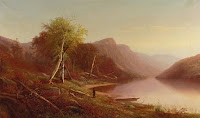 A newly discovered piece of folk art appears to be the early work of Rensselaer County artist Joseph H. Hidley. The work, a small graphite drawing signed “Drawn by Joseph Hidley, 1841, age 11,” was purchased at a Massachusetts auction by Halsey Munson, a Decatur, Illinois a dealer in early American furniture, accessories and folk art. Although the authenticity of the piece has not yet been definitely established, it is an early townscape of the Hudson River village of Saugerties, similar in style and composition to Hidley’s other work.
A newly discovered piece of folk art appears to be the early work of Rensselaer County artist Joseph H. Hidley. The work, a small graphite drawing signed “Drawn by Joseph Hidley, 1841, age 11,” was purchased at a Massachusetts auction by Halsey Munson, a Decatur, Illinois a dealer in early American furniture, accessories and folk art. Although the authenticity of the piece has not yet been definitely established, it is an early townscape of the Hudson River village of Saugerties, similar in style and composition to Hidley’s other work.
Joseph Hidley’s short career is well represented in regional, state, and national museum collections. If authenticated, “Saugerties” would be the earliest known work of Hidley who painted genre scenes, religious allegories, and land and townscapes while also working as a taxidermist and house, sign, and wagon painter.
The work is remarkably similar to a portion of William Wade and William Croome’s Panorama of the Hudson River from New York To Albany, which was published in 1846. The finding suggests that Hidley may have known William Croome, and copied his work before it was published.
The first step, according to Munson, is authenticating the work. “In all of this, I’ve spent a considerable amount of time studying the published Hidley works and comparing them with the piece I have,” Munson told me via e-mail. “Even allowing for my understandable desire for this piece to be right, I’ve found enough solid points of similarity to give me quite a bit of confidence that this could easily be by Joseph Hidley.”
The image shows the first lighthouse at the mouth of the Esopus Creek at Saugerties, built in 1838 with funds appropriated from Congress, to guide ships away from nearby shallows and into the Esopus Creek when Saugerties was a major port. The light used five whale oil lamps with parabolic reflectors and was replaced in 1869, by a lighthouse that still stands. The foundation for the original lighthouse can still be seen adjacent to the existing lighthouse.
Photo provided by Halsey Munson.







